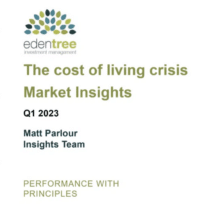Prime Minister Rishi Sunak’s biggest achievement in his first 100 days in office could be the impressive sterling investment grade credit market recovery, according to Euan McNeil, fixed income investment manager at Aegon Asset Management.
But with aggregate spreads still elevated, and the Bank of England unlikely to match its rhetoric on hikes, McNeil believes there is still some way for the market to go.
The manager says sterling investment grade credit has performed remarkably well since Sunak took office, in a significant turnaround after Liz Truss’s short tenure.
“Since the end of the disastrous and short-lived Truss tenure and the nearing of Rishi Sunak’s first 100 days as UK Prime Minister, markets have performed extremely well,” he says.
“Sterling investment grade bonds have returned 8.8%, aided by a material recovery in the gilt market (10-year gilt yields are lower by around 60 bps over this period) and an even more impressive compression in investment-grade spreads.
“This happened for a combination of reasons – falling inflation; renewed fiscal credibility; lower gilt supply expectations; easing concern about central banks tightening; and an acknowledgment that sterling investment grade valuations reached extreme levels.”
McNeil believes the recovery is not a surprise, as valuations looked extremely attractive when Sunak took office in mid-October, which he noted at the time. But what happens next in the market is less clear, although he does not believe the Bank of England is likely to match its ongoing rhetoric on rate rises.
“We weren’t surprised by the recovery as sterling investment grade credit looked particularly attractive in mid-October,” he says. “But what happens now is much trickier. While retail figures for the festive period beat dire expectations, it would be a stretch to describe the UK consumer as being in rude health. But inflation should continue to moderate, particularly aided by lower energy prices.
“Current market expectations for the Bank of England are for base rate to peak at close to 4.5% in Q3. But the bank will ultimately fall short of this. We would not be surprised to see its prevailing rhetoric err on the hawkish side in the interim, as it wrestles with a desire to regain credibility. Ultimately though, delivering four further hikes before the end of Q3 of 2023 will be a challenge.”
With that in mind, McNeil believes there is further for the market to go, with aggregate spreads still relatively high compared to the long-term average.
“Sterling credit spreads reached a wide point of 250 bps in mid-October and have since retraced around 80 bps, reaching an aggregate level not seen since June 2022. While the ‘easy’ money has undoubtedly been made, aggregate spread levels are still elevated compared to the past 10 years.
“The all-in-yield figures are just as compelling, with a current yield-to-maturity of more than 5%. This figure was closer to 2% at the start of 2022 and 1.4% at the end of 2020, albeit clearly operating under a different monetary policy regime.
“The global economic backdrop has deteriorated in recent months. The consequence seems to be greater confidence that central banks are now willing to countenance that the worst of inflation may be behind us. This should allow for further tightening of credit spreads.
“If our assumptions around the likely path of interest rates and credit are broadly correct, then a mid-single-digit total return for the remainder of 2023 would not be a surprise.”


































